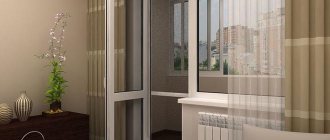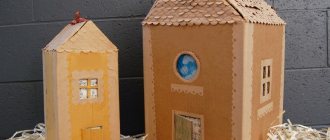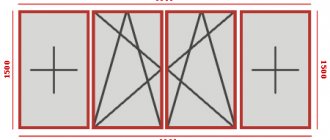The threshold on the balcony is an integral element of the interior of the room adjacent to the balcony. If the appearance of this element leaves much to be desired, then no matter how beautiful the room adjacent to the balcony or loggia is, an old or poorly finished threshold will be striking and spoil the integrity of the picture. And if it still blows, then installation or replacement is simply necessary.
In this article, we will look at how to make, replace and finish the threshold on a balcony step by step without involving specialists, since this type of work does not require additional skills and there is an opportunity to save money .
Assembling a laminate threshold
The entire process of installing a balcony threshold is quick and easy, you just need to follow the following technologies:
- Installation begins with the design of the future product. It is best to make a diagram with the specified threshold parameters, its height and width. At the same time, according to the first point, you should not make it too large, otherwise it will create inconvenience when moving. A very low level is not needed for the threshold to fully perform its functions.
- The old finish must be removed from the surface at the construction site, clearing it of debris and dust.
Also, before laying a new flooring, you need to treat the base with antiseptics to prevent the formation of fungus and mold. Preparing the threshold for laminate installation - If you need to make a threshold from scratch, then such a step must be mounted from concrete as a base. To do this, they demolish the old structure, clear the place, and assemble the formwork taking into account the height of the future product.
- Concrete needs to be reinforced, for which thin reinforcement (diameter 8-10 mm) is suitable. It is cut into pieces, mounted vertically on the floor, and tied with horizontal rods.
- Prepared concrete is poured into the finished formwork in a ratio of 1:3:3 (M400 cement), where cement, sand and crushed stone are mixed, respectively.
- The poured mixture is leveled with a trowel or a spatula, then left to dry for several days (it should harden within 24-48 hours).
- The laminate is laid on a substrate that is also used for the main flooring.
Moreover, the location of the board must be chosen according to the main coating. All fastening work is done using wood screws. The process of installing laminate flooring on a balcony step
The video shows the process of assembling a laminate threshold.
You can also make a threshold from brick, laying it with cement mortar. Making a balcony threshold with a laminate finish is simple and does not require large expenses. It is only important to follow installation technologies and purchase high-quality material.
Installing a plastic threshold on point supports
PVC plastic (the same one used for window sills) is the simplest and most inexpensive solution when decorating a threshold for a balcony door. There is an opinion that it bends, and therefore is not suitable for installation on surfaces that are intended to be stepped on. But this only happens if the installation technology is violated. Two installation methods are practiced:
- on point supports - the cheapest and fastest;
- on a slab of mortar or polystyrene foam - more expensive and labor-intensive.
Let's consider the first method in detail. It is convenient because it does not require preliminary leveling of the base and the cost of mixtures or slabs. Installation of such a structure can be completed in a few hours. Sequence of work:
- Clean the base from dust, dirt, and foam residues.
- Take measurements and make a preliminary sketch.
- Cut the blank for the future threshold from a plastic window sill with maximum precision so that the joints between the threshold and the adjacent walls are minimal.
- Prepare wooden blocks with a cross-section of approximately 10*5 cm and a height equal to the distance from the floor to the lower edge of the threshold.
- Lay out the bars in a row, first on the left and right. Check the level.
Then lay a few more rows (5-6 rows are enough for a threshold length of up to 1 m). If you deviate from a strictly horizontal line, file or extend the bars.
- Try on the threshold, check the entire structure with a level again.
Remove the workpiece, apply polyurethane foam, but not too much, since when it hardens it expands and can displace the structure.
- Gently press the threshold against the supports.
- Place a weight on top.
- After hardening, apply sealant or liquid plastic at the junction points, and close the ends with plugs.
Installing a plastic threshold on a pre-built slab is done in the same way.
Proper sizing is the key to success!
The standard sizes of door leaves are
- height 2000 mm
- width 600 mm, 700 mm, 800 mm and 900 mm
All other sizes that go beyond the scope are usually custom-made items. (I mean single canvases, not swing ones)
You need to add 70 mm to the size of the door leaf - this is the standard width of the door frame. If the dimensions of the door frame are different, then the size will naturally change up or down. And we also add 6 mm - this is the technological gap between the leaf and the door frame.
Now you need to check how the door frame fits into the doorway. If it needs to be expanded, then we are not in a hurry to break everything at once. We soberly assess the situation - we may have to strengthen the opening with lintels. If you need to reduce the opening, then we fill it with bricks, or “sew on” bars - it all depends on the situation.
Usually the dimensions of doorways are controlled at the construction stage, but in older private houses (like mine) there are “hard” discrepancies.
The next important dimension is the gap from the floor to the door leaf. Before calculating it, you need to check the level of the floors for the width of the door “swing”.
You can do this in two ways:
- Using a hydraulic level
On the side walls of the opening we place marks at the same level. We measure the distance from each mark to the floor plane. The difference that you get when measuring should be added to the minimum height of the posts so that when opening the door does not rest on the floor. If you still “miss” this moment, then you can eliminate it only by trimming the door leaf, and this is still a “handjob” :(
2. Using a laser level
If you are the happy owner of a laser level, then everything becomes much simpler. We set the level and, using a construction square, determine the curvature of the floors. The obtained values are taken into account when setting sizes.
The minimum gap is 10 - 15 mm, depending on what kind of floor covering is planned. But it is better to immediately lay linoleum, or carpet, or laminate, and then carry out the installation.
See the table of correspondence between door blocks and openings.
And here is another table of typical door frame sizes
Laminate and threshold at the balcony door, problem
There is a room with a balcony door (double glazed windows) in which laminate flooring is laid. The problem is that the threshold from the laminate door is still just an experiment. The height of this threshold starts FROM the height of the baseboard and above, already up to the frame of the balcony door with a slide. It turns out that pieces of laminate cannot be placed on this threshold for two reasons: 1. the end of the tiles is higher than the baseboard along the perimeter of the room 2. the tiles cannot be placed adjacent to the slopes, since you need a distance to the wall, which cannot be covered with anything, again due to the fact that that pieces of skirting boards will seem to be in the air relative to the main skirting boards. All that remains is to paint this threshold with white paint, but this does not seem to be solid or interesting. Maybe someone has encountered a similar problem, or just have any thoughts on this topic? I apologize if I explained it confusingly. Thank you
Almost everyone has this problem. I put granite tiles on this threshold, you can put ceramic granite that imitates natural. You can glue the laminate, since the area is small, there will be no expansion. Cover the end with an L-shaped profile. Silicone the junctions with the slopes.
For me, this threshold, when the windows were replaced, was made from a piece of plastic window sill.
Domino wrote: There is a room with a balcony door (double glazed windows) in which laminate flooring is laid. The problem is that the threshold from the laminate door is still just an experiment. The height of this threshold starts FROM the height of the baseboard and above, already up to the frame of the balcony door with a slide. It turns out that pieces of laminate cannot be placed on this threshold for two reasons: 1. the end of the tiles is higher than the baseboard along the perimeter of the room 2. the tiles cannot be placed adjacent to the slopes, since you need a distance to the wall, which cannot be covered with anything, again due to the fact that that pieces of skirting boards will seem to be in the air relative to the main skirting boards. All that remains is to paint this threshold with white paint, but this does not seem to be solid or interesting. Maybe someone has encountered a similar problem, or just have any thoughts on this topic? I apologize if I explained it confusingly. Thank you
Removing the slopes is not a problem for a person with straight arms; buy a piece of PVC window sill, install it, put the slopes in place, having first sawed off the excess height.
Reviews
Komisarenko L.B.
: Our balcony door to the loggia broke. We couldn't close it after airing it out. I would like to express my gratitude to the masters of PermOknaService Oleg and Roman. They arrived to repair the balcony door very quickly. The problem was identified and corrected. The craftsmen were polite, behaved correctly and professionally. But the most important thing is that the balcony door now closes and opens perfectly.
Alexander
: They called a technician to repair a PVC balcony door - the handle on the street side was broken and cracked. They arrived quickly and brought a handle - not the plastic one we had, but an aluminum one. Additionally, we installed a latch for the balcony door, also aluminum. The price suited us quite well - it turned out the same as if I had gone to the store myself, bought it and installed it.
Kolobov A.N.
The wooden door to the loggia did not close. The price for repairing a balcony door at PermOknaService was quite satisfactory to us. There was also no need to wait for a specialist. First, he removed the faulty part, closed the door and sealed it with tape. I brought new fittings and installed them. All this in one day, literally in 1.5 hours. We also didn’t pay any extra money - the price completely coincided with what the manager told us over the phone.
Pros and cons of the threshold to the balcony
The threshold to the balcony has its advantages:
- Provides additional protection against cold penetration into the room;
- Facilitates the transition from room to balcony;
- Improves the aesthetic appearance of the balcony door and the adjacent room.
Also, the height of the threshold on the balcony is often made lower than required. And as a result, when moving to the balcony, you can trip over the remaining height under the door. With correct calculations and installation work, this design has no disadvantages.
If there is no threshold, then from under the door leading to the balcony or even a glazed loggia there will be constant air blowing.
Linoleum
The necessary measurements are taken, then a linoleum blank is cut out from them. Then they coat its base with construction glue and press this piece of linoleum to the surface of the threshold. To ensure that its joints are less subject to various damages in the future, metal corners are attached.
This finishing of the balcony threshold goes well with wooden floors or laminate flooring. In addition, if the doors and walls of the room are light, the dark threshold will stand out perfectly against their background.
Original tile threshold
Ceramic tile flooring is durable and easy to maintain. If you choose this type of material to finish the threshold, then in this case you cannot do without preliminary construction of the base, which can be done in several ways.
Brick base
This option is justified if the difference between the floor and the doorway is large enough (no less than the height of the brick). Please note that a layer of leveling mixture and finishing tiles will be applied to the brick - the finished height of the threshold should not overlap the door. Main stages of work:
- Clean the base as thoroughly as possible. The smoother the surface, the easier it is to lay the brick row.
- Prepare a cement-sand mortar in a ratio of 3 parts cement to 1 part sand. You can use store-bought mixtures that simply need to be diluted with water in accordance with the manufacturer's recommendations.
- Distribute the mortar over the base and lay out the first brick. Then apply the mixture to the end side of the brick so that all the seams are filled. Place the next block and so on. Usually one row is enough to build a threshold.
- Apply a layer of mortar to the entire upper surface of the brick row and level it.
- When the mixture dries, moisten the surface with a small amount of water and treat with a foam float. This results in an almost perfectly flat surface.
Filling the base with mortar
When you need to get a threshold of a smaller height than the size of the brick, it is rational to use this method. Many masters prefer it in most cases due to its ease of execution. The work is carried out in the following sequence:
- Prepare the base, remove debris and dirt, cut off excess polyurethane foam. Treat the surface with a primer.
- Install the formwork. To do this, you need a board slightly larger in width and height than the size of the threshold - you just need to press it tightly against the wall with any heavy objects.
- Prepare the solution according to the directions on the package.
- Place filler into the cavity of the future step: broken brick, stone, crushed stone.
- Carefully pour the solution so that it fills the entire volume. Level with a staple and remove excess.
- After a few hours, moisten the surface and rub with a float.
Selecting and laying tiles
Among the wide variety of finishing materials, you can easily choose an option that suits the overall style and design of the room. There is no need to buy expensive brands for this area. Residual and even defective lots with different shades or chips are suitable - such material can be purchased at a significant discount. Tastefully selected details of different textures and colors and mosaics look original. The main thing is not to choose glossy surfaces - they can be very slippery.
You can tile not only the horizontal surface of the step, but also the partition underneath it, as well as the area of the floor adjacent to the door. It all depends on the taste of the owners and the characteristics of the room. Laying is done in the following sequence:
- Carefully take measurements, calculate the quantity, draw a layout diagram. Symmetrical installation looks better and neater, especially on large slabs. There should be whole parts in the middle, equally trimmed on the sides.
- Cut the tiles using a tile cutter or grinder.
- Coat each part with special glue and place it on the finished base in accordance with the diagram. Insert crosses between the tiles - this way the seams will be smooth and uniform. Control the laying process with a level.
- After hardening, remove excess glue and fill the seams with grout mixture.
Finish options
It goes without saying that a floor covering should be laid on a threshold made of concrete or brickwork. Although, perhaps, it should be placed on a wooden threshold. In any case, all options provide a good basis for laying any topcoat.
So, we will consider several options for the development of events.
Option 1. Tiling
The tile fits perfectly on brickwork or on a concrete base. Here's what you need to do to properly tile the threshold:
- apply a primer to the surface to increase adhesion,
- While it is being absorbed, calculate the location of the tiles and take the necessary measurements. The tiles should lie evenly and symmetrically,
- prepare the tiles for laying. To cut the tiles evenly, use a tile cutter or a regular grinder,
- prepare tile adhesive according to the instructions on the package,
- apply the finished composition to the back of the tile using a notched trowel,
- To ensure that the grout joints run smoothly, use special plastic joint crosses. The width of the seam should be from two to four millimeters,
- fill the grout joint with a fugue, which will protect the material from moisture and give the work a finished look.
Keep in mind that the presence of seams when laying tiles is mandatory (!) This is not just a decorative element. These seams prevent cracking and peeling of the material from the working surface due to temperature changes. Essentially, this is the same delatation gap. Simply put, this is the play that allows the tiles to expand freely as the temperature rises.
If you wish, you can also tile part of the wall under the threshold - depending on your design decision and the ability to translate it into reality. Read more about working with tiles in another article: “How to lay tiles on the wall yourself.” If you have a question: “What does the wall have to do with it?!”, I will answer: the principle of working with tiles is almost always the same, regardless of the plane in which the action takes place. Enough about the tiles. Now let's move on to the next option.
Option 2. Laying flooring
The second option can be summarized by calling it “flooring installation.” But floor coverings are different. First, let's look at the laminate trim on the threshold. The algorithm of actions in this case is as follows:
- necessary measurements,
- cutting the laminate according to measurements. As a rule, one board is quite sufficient. For cutting, you can use either a hacksaw or a jigsaw. The main thing is not to cut off extra centimeters, so as not to spoil the board,
- fixing the laminated board to the surface using liquid nails,
- fixing the corner. These are usually sold in hardware stores in the flooring department.
In addition to laminate, you can attach other flooring to the threshold. For example, linoleum carpet or vinyl tiles (art vinyl™). This option is even simpler, since the materials mentioned are quite soft and can be cut with an ordinary stationery knife. Plus, you don't need a large piece, and at the hardware store you can select a small piece from scraps, which come in a variety of sizes and are usually sold at a discount. The smaller the fragment of flooring in area, the greater the discount on it. Some are sold for only 20% (or even less) of the cost per square meter of roll coating.
If you decide to use linoleum/carpet, simply take measurements and then trim the excess from a piece of flooring according to these measurements. Then simply glue it to the surface using linoleum and carpet adhesive. But if you have liquid nails or other glue at your disposal, use it. After all, buying a bucket of special glue (even a small one) just to glue such a small piece is impractical. When the covering is glued, fill the corner, which will protect the protrusion from damage during operation.
Other types of materials
To finish the threshold on the balcony door, you can use other materials:
- Natural wood. Eco-friendly, holds heat well. Looks appropriate in interiors made in eco or country styles. Working with it requires certain skills and abilities. The main disadvantage is the high cost.
- Laminate. It is a cheaper analogue of wood, but has good aesthetic and thermal insulation properties.
- Linoleum. One of the most inexpensive and easiest to work materials.
- Cork. An environmentally friendly material that gives originality and exclusivity to the interior. Has excellent thermal insulation properties. The main disadvantage is softness and instability to damage.
So, it’s not difficult to give a finished look to a balcony door. Carefully consider the design solution, and then carry out the work correctly - as a result, the room with a balcony will become even more cozy and comfortable.
Method 2. Filling the solution
This method is appropriate if the threshold just needs to be raised a little. To a height that is less than the height of the brick (6.5 cm). But in some cases it can be used regardless of how high the threshold is supposed to be mounted. This method is quite popular, and, according to many builders, it is more convenient and faster than the previous one.
From building materials we will need:
Here is a small list of tools that will be useful to us during our work:
The work of filling the threshold occurs according to the following scheme:
We'll talk about finishing later. In the meantime, we are waiting for a third option to resolve the issue.
Threshold made of metal profile
In some cases, when it comes to arranging a door threshold of a complex (not rectilinear) shape, it is necessary to use a metal profile used for installing plasterboard and waterproof plasterboard with a thickness of at least 10 mm. No preparation of the base is required, except for cleaning it from excess construction debris and dust.
According to the pattern, or markings on the floor, a metal profile is mounted to the base, screwed to the concrete base with self-tapping screws into a dowel or anchors, then vertical posts of the required height are installed, fastened to the profile by means of fastening units and metal screws, and then the upper horizontal one, symmetrical to the lower one, circuit. It should be taken into account that the threshold will be under constant load, therefore the number of fasteners and the frequency of their location when arranging the threshold should be increased by at least 3 times, compared with the recommended frequency of their use when facing plasterboard walls or ceilings.
For additional thermal insulation, the space between the concrete base and the upper plasterboard panel of the threshold is filled with mineral wool or filled with expanded clay gravel. If the threshold being installed has curved lines, the facing of the end surfaces should be made of ordinary (non-moisture-resistant) plasterboard 5 mm thick, previously soaked in water, to give it flexibility. After installation, the end part of the threshold should be puttied with oil-adhesive putty to impart water-repellent properties.
Instructions for making a plastic threshold
For glazing, PVC profiles are often used - safe, durable, airtight, and have a long service life. Window sills are also made from a thick sheet of plastic covered with laminate. Therefore, you can use PVC parts to decorate other interior elements; they will look appropriate. For example, wall cladding with comfortable wide panels can be supplemented with a plastic threshold for the balcony - this is one of the most budget-friendly and affordable solutions.
Wide threshold made of plastic panel
Preparation of material and tools
Externally, the step will resemble a window sill, that is, it will consist of a wide panel closed on the sides with plugs. If the length of the inner part is large, you will have to use several strips connected to each other. Therefore, it is necessary to purchase plastic parts according to the dimensions of the working area and additional elements for decorating the cut sides if they protrude above the floor level. For point supports, 1-2 bars are enough, for a cement screed - a bag of dry mixture.
>
Jigsaw for cutting wood and plastic blanks
It is best to attach plastic to any type of base using polyurethane foam or liquid nails; we will mask the seams with sealant. For cutting you will need a construction knife, file or electric saw. The panels are completely ready for use, so no additional processing is required. If necessary, you can align the end parts with a file or knife. We will carry out preliminary markings using a square, tape measure, level and pencil.
Option No. 1 - on a cement screed
The screed is preferable for preparing the base for any type of finishing, as it has the necessary strength and levels the floor surface. It is better to carry out all the cement work at the same time, that is, before erecting and finishing the threshold for the balcony, start preparing the entire area. This way you can save on material and time. However, the processes of glazing and laying floors most often extend over a period of time, and some activities have to be done separately.
Finished cement step
Screed on a small area is prepared according to general rules:
We prepare the solution according to the standard scheme or instructions included with the finished dry mixture. Don’t expect the screed to dry quickly; complete readiness will occur only after 1-2 weeks. This is a disadvantage of installing concrete structures, and if it is necessary to urgently carry out repair work, you should choose another method.
When the cement step “ripens”, remove the blind area, fill the resulting gaps with plaster or polyurethane foam and install a plastic panel cut to size. To fix it, we place it on liquid nails or foam. We decorate the sides in the same way, masking the joints with sealant. The advantage is that if the plastic threshold on the balcony cracks, it can always be repaired by simply replacing the panel.
How to make and veneer a threshold from brick or concrete
Piece building material is used for large distances from the door frame to the floor of the room. Apply putty to the cleaned and leveled floor surface and lay bricks on it. To hold the materials together, a mixture of cement and sand (1:3) is useful.
The first layer is cement, the second is brick. After the entire structure has set, cover the brick with a layer of cement composition, level it and tile it. Remnants from the collections with which the bathroom was lined will be useful as finishing. You only need a few tiles, so finishing does not require large investments.
The brick structure will last for several decades. The cement mixture is used for small forms. Mix sand with water and cement, build formwork in the area where the threshold is formed, pour in the composition and wait for it to dry. After drying, cover with any material.
Arranging a threshold using a cement-sand mixture
If the difference between the main floor and the lower edge of the door frame is not very large, then the threshold of the balcony door can be made with your own hands using ordinary mortar.
To perform this method you will need:
- a narrow board at least 2 cm thick and slightly longer than the width of the doorway for making formwork;
- dry cement-sand mixture;
- hand-held electric drill with a special mixing attachment;
- putty knife;
- building level.
Low balcony thresholds are installed using cement mortar in the following sequence:
- 1 Installation of formwork begins with preparing the area where the threshold will be installed. To do this, you need to remove any debris from it.
- 2 Prime the surface.
- 3 Install the formwork at the level of the end surfaces of the wall.
- 4 Using a hand-held electric drill with a mixing attachment, prepare a solution from a mixture of sand, cement and water.
- 5 It is advisable to add small fractions of broken brick or crushed stone to the place where the finished mortar is poured. This filling will turn the poured mixture into something similar to concrete. In this option, the threshold for the balcony will be more durable and will make it possible to ensure a longer service life.
- 6 The solution is being poured.
- 7 Use a spatula to carefully level the space filled between the formwork. This operation is necessary because the result is a finishing surface.
After drying, such small balcony thresholds are ready for cladding. Ceramic tiles, linoleum or laminate can be used as finishing materials.
Preparatory work
The first step is to make the base. There are two options for creating a base for the threshold: from brick or from cement-sand mortar. If you already have a level base that is suitable in height, then you can skip this step and immediately begin finishing.
The height of the base of the threshold is made taking into account the fact that a layer of finishing material will be laid on top. The point is that the finished balcony threshold does not interfere with the opening and closing of the balcony door.
how to remove rust from a metal door
Instructions for creating a brick base:
The brick base is made when there is a large difference between the balcony frame and the floor (not less than the height of the brick).
After all these steps, the threshold will be smooth and you can proceed to finishing.
Instructions for creating a base from cement-sand mortar:
This method is suitable if the height of the base of the future threshold is less than the height of the brick.
The base is ready. Now you can start cladding with any material you like.
Wood threshold on the balcony
The threshold to the balcony with your own hands
The most striking advantage of a wooden threshold is that it almost does not allow cool air to pass through. If it is additionally insulated with good mineral-based wool, the effect will be even more optimal.
To begin with, we take wooden blocks and assemble the sheathing from them. It will have to be firmly screwed to the floor surface. For cladding, use a slab of pressed wood chips. It can easily support heavy loads without deformation.
In the production process of a wooden threshold you will need:
- Wood screws
- Corners for adhesion of timber to the floor
- Drive-in screws with dowels
- Hacksaw
- Hammer
- Impact drill
- Hardwood timber
To begin with, we take the prepared timber and make a frame comparable in size to the size of the upcoming threshold. The screws with which you will fasten the frame should be twice as long as the edge of the beam.
Balcony door threshold trim
If the frame is absolutely ready, we place it in the place where the threshold should be, and mark the internal edges with a construction pencil. Holes for dowels must be drilled in the inner corners. Next, we put the finished frame in place and, using the previously made holes in the corner of the beams, secure the frame to the floor surface. It must be strong and reliable.
Next, we cut out a sheet of particle board and carefully lay it down and secure it with screws. Upon request, the structure can be insulated with polystyrene foam or mineral wool. We recommend using good linoleum or laminate as finishing.
Essence of the question
Before we begin to directly discuss the topic, let's briefly highlight the essence of the issue regarding the plastic (or any other) threshold on the balcony door. Why is it needed and is it possible to do without it?
If you decide to level and insulate the floor on your balcony by screeding or installing wooden joists, then the floor on your balcony will naturally rise. The height that it “reaches” can be different (up to 20 cm). However, now this is not so important to us. The important thing is that it should not exceed the height of the floor in the adjacent room. Theoretically, this is, of course, possible, but there is no practical sense in it.
Some craftsmen mistakenly believe that a concrete (or whatever) threshold serves as a guide for raising the floor. But no, no, and again - no! It is not the threshold that serves as a guide, but the floor and only the floor in the adjacent room. And nothing else.
Theoretically, this threshold can be dismantled to create a feeling of a single space with the room. If you really want, you can even connect the balcony with the kitchen, living room, bedroom or other room. There is a separate article about this on our website. If dismantling the threshold does not cause freezing of the ceiling (this is bad, first of all, for your neighbors below), and in general, if this threshold does not play any role, then it can be dismantled without unnecessary regrets and fears. Unless, of course, you want to visually combine two spaces: a balcony and a room.
But we are talking about exactly the situation where a threshold is provided. We keep talking and talking about some kind of threshold, but what exactly we are discussing is not entirely clear. At least, if I were a person reading this article who has never insulated a balcony or installed plastic windows, and in general has not dealt with repairs and construction, it would not be entirely clear to me what we are talking about. And the value of information lies not only in /what/ is said, but first of all in /how/ it is said/written. That is, the main thing is accuracy and clarity.
Let us now bring this necessary clarity. The fact is that often a plastic door to a balcony is, in fact, the same window, only larger. And it functions on the same principle as windows. Only, as a rule, the door does not have a “ventilation” function. Although, if desired, you can not add this function to the windows, and you can safely add it to the door. However, this is not particularly important for us now.
It is important that the very concept of “balcony of a metal-plastic door” is conditional. Technically, this threshold is the lower part of the metal-plastic frame. There is nothing to say about this part of the door. At least in the context of our conversation.
And the article is about that concrete elevation that is located at the junction of the room and the balcony. At the final stage of the repair work, we have to decide the question of how to install the threshold of the balcony door. Technically, making such a threshold is not as difficult as it seems. At least if you have already done most of the work, then you have passed the most difficult stage. Therefore, the threshold for you is a mere trifle.
In the course of the text, we will analyze four traditional methods of constructing a threshold, but, as we understand, improvisation in the repair and construction business can be very appropriate. It all depends on how expedient and functional it is, and, in fact, the threshold can be made even from the computer keyboard with which this text was typed. But whether such a non-standard solution will be practical and durable is a big question.
Each of the four methods described in the review has proven its reliability and practicality, so we will not argue that some of them are better and some are worse. You just need to choose the option that best suits the design and style of the interior. After all, if the interior is designed, say, in the style of Hi-Tech or minimalism, a wooden threshold will look inharmonious and conspicuous, creating an unpleasant contrast. Again, you need to look at the situation and strive to create harmony in the interior. Let's get started.
We make a threshold for the balcony from laminate or install a plastic one
Nowadays, the balcony is no longer exclusively an auxiliary room in the house. It can serve as a bedroom, guest room or kitchen. Therefore, renovations in this part of the apartment should be carried out conscientiously, using modern technologies and materials. When you are arranging a loggia, an important stage of work is laying the floor and decorating the threshold.
Some owners of apartments with balconies even dismantle this step between the room and the auxiliary space, mistakenly believing that it is not needed. However, the balcony threshold performs several useful functions. Firstly, it makes the balcony structure more durable. Secondly, it keeps the room warm. When the door to the loggia is located in line with the floor, cold air easily penetrates into the room. Protecting this area from freezing temperatures will not be easy. Therefore, the best option is to raise the door a little. Thus, the threshold acts as a heat-insulating element.
Threshold to the balcony: made of plastic and ceramic tiles
After installing a double-glazed window with a door to the balcony, it is necessary to carry out final work on installing the threshold. This unit performs an important function - it prevents cold from entering the room. But one should not forget about the aesthetic component - this is a prerequisite for proper repair. At a minimum, the threshold to the balcony must be decorated carefully, otherwise the entire effect of the fresh interior will be ruined. If desired and possible, it can be made the highlight of the room.
Sources
- https://vdomvse.ru/balkon/porozhek-na-balkon-iz-laminata.html
- https://svoyadver.ru/porogi/porog-na-balkon-iz-laminata.html
- https://stroy-rem.net/podokonniki/delaem-porog-na-balkon-iz-laminata-ili-stavim-plastikovyj.html
- https://balkonoved.ru/remont-i-otdelka/montazh-otdelka-i-zamena-poroga-na-balkone-svoimi-rukami-poshagovaya-instruktsiya-c-foto-i-opisaniem
- https://art-pol58.ru/bez-rubriki/porozhek-na-balkon-iz-laminata.html
- https://okna-dom.net/porog-na-balkon/
- https://MirHokkey.ru/okna/porog-na-balkon-iz-laminata.html
- https://proffstroygroup.ru/dekor/vidy-porogov-dlya-laminata.html
- https://sdelaibalkon.com/remont/pol/porog-na-balkon
[collapse]











